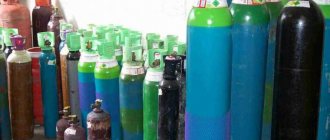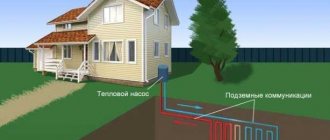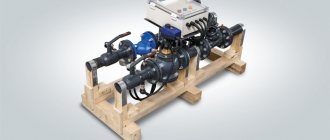Here you will find out:
- Heating types
- Alternative heating for a cottage or private house
- Pros and cons of different types of coolants
- What heating in a cottage is most profitable
- Comparison of costs of different heating systems
- One- and two-pipe heating systems
- The main elements of a water heating system
- Which heating radiators to choose
- Cottage heating system installation
Regardless of whether an old system is being modernized or it is being designed from scratch in a newly built house, the first thing to start with is familiarization with the regulatory documentation. It describes in detail how the equipment is put into operation, and describes the subtleties and features of its further use.
Having spent some time on this, you can be sure that the heating system will last far more than one year. The requirements are adjusted and updated from year to year. But there are some principles that every cottage owner should know. The first thing to ensure when installing a heating system is explosion and fire safety.
For safe operation during installation, you need to take care of free access to the equipment for cleaning and regular checks.
The list of rules that will help make a private house not only cozy, but also safe for living should include the following aspects:
- The temperature of the open elements of the heating system should not be higher than the manufacturer's recommended temperature.
- Equipment and all appliances must be properly insulated. This will avoid burns, eliminate moisture build-up and reduce heat loss. In addition, hot elements can ignite dust, gas or aerosols in the room.
- When using a coolant, the temperature of the latter must be 20 degrees Celsius below the temperature of its evaporation or self-ignition. For example, if water is used in the system, then it must be prevented from boiling. Raising the pressure is a great solution.
Also, operational requirements are imposed on the heating system. After all, any equipment should be as strong, durable, easy to operate, quiet and easy to repair.

It is better to order equipment from trusted manufacturers. Such companies produce really high-quality products, as they are responsible for it with their own name.
By choosing a boiler, radiators and pipes that best meet the listed criteria, you can save yourself from many problems.
Heating types
There are two types of heating for country houses: autonomous and centralized heating. They are divided into several subspecies operating on different energy sources:
- Natural gas.
- Liquid fuel - gasoline, diesel, diesel oil.
- Solid fuel - wood, pellets, coal.
- Electricity.
- Natural sources of energy.
Each of them has its own set of benefits that can be beneficially used under certain conditions.


Country house heating equipment
Biofuels as an alternative to conventional heating
One of the most effective and affordable ways to heat a country house is a biofuel boiler. This type of alternative heating uses production waste for its work - crop husks, wood chips, sawdust and other by-products of the woodworking industry.
There are many pellet boilers.It is possible to automate the process of fuel supply so that everything happens without the participation of the owner
Dense compressed granules of small size - pellets, which are burned in boilers, are made from various wastes. Compared to conventional wood, such fuel burns longer and allows you to get more heat. Also, large dense briquettes are made from various types of vegetable waste. Such compressed fuel allows you to get 2-4 times more heat energy. Its heating value is up to 5.0 kWh / kg.
Pellets, in contrast to briquettes, have a much smaller size. They are used in an automated heating system. Briquettes are more efficient, but have a larger size.
Biogas can be used for a gas boiler. It is not difficult to get it in the process of decaying organic waste. To do this, you will need to build a sufficiently voluminous tank, place waste into it, provide for an installation for mixing them. Under the influence of air and bacteria, the process of decay and gas evolution will occur. A pipeline is to be installed to discharge the waste material. Also, to collect gas in special tanks, purify it and move it to the heating system, you need to use the appropriate devices.
An environmentally friendly heating method using an alternative source of heat generation - a hydrogen boiler. At the heart of its work is the reaction of the interaction of hydrogen molecules with oxygen, during which a huge amount of heat is released. This type of heating requires compliance with operating rules and safety precautions.
The principle of operation of a hydrogen boiler is based on a chemical reaction between hydrogen and oxygen, resulting in a lot of heat and no harmful substances. But you need to follow the safety rules
The main disadvantage is the high cost of factory equipment. The way out of this situation is to equip the hydrogen heating system on our own. For its operation, you will need a constant connection to the sources of electricity and water, a hydrogen burner, a hydrogen generator, catalysts and the boiler itself. The heat obtained as a result of a chemical reaction enters the heat exchanger, and plain water is used as waste.
Alternative heating for a cottage or private house


Heat pumps or solar collectors are most often used as alternative sources of thermal energy. The latter can also be a source of electricity. The cost of such equipment at the moment is astronomical and only owners of large, very large residential buildings can afford them, where such investments will pay off in the foreseeable future. In developed countries, governments actively subsidize the use of such equipment. Well, in the former USSR, the use of heat pumps and solar collectors is much more expensive than gas, coal and even electricity.
Solar panels. How solar heating system works
Solar heating can also be included in the list where all the new technologies for home heating are present, in which case not only photovoltaic panels, but also solar collectors can be used for heating. Photovoltaic panels are practically out of use, since collector-type batteries have a much higher efficiency indicator.
The latest solar heating systems for a private house include components such as a collector - a device consisting of a series of tubes, these tubes are connected to a tank that is filled with coolant.


Heating scheme with solar collectors
According to their design features, solar collectors can be of the following varieties: vacuum, flat or air. Sometimes in such modern heating systems of a country house, a component such as a pump can also be included. It will be designed to provide mandatory circulation along the coolant circuit. This will facilitate more efficient heat transfer.
In order for solar heating system technology to be most effective, there are some rules to follow. Firstly, such new heating technologies for a country house can only be used in regions where it is sunny at least 15-20 days a year. If this indicator is lower, then additional new types of heating of a private house should be installed. The second rule dictates that the collectors be placed as high as possible. They need to be oriented so that they absorb as much solar heat as possible.
The most optimal angle of the reservoir to the horizon is considered to be 30-45 0.
To prevent unnecessary heat loss, it is necessary to insulate all pipes that connect the heat exchanger to the solar collectors.
Thus, we see that the development of technology does not stand still, and new developments in heating homes are as much a necessity as the modernization of equipment that we use every day.
Innovations in the heating system use completely new and unusual for us - heat energy from different sources.
Modern types of heating a private house sometimes boggle the imagination, however, in modern times, each of us can already purchase or make such a modern heating of a country house or private house with our own hands. New in heating a private house are efficient systems that continue to develop the field of heating equipment, and we hope that all the most effective options are yet to come.
The heating system in a newly built house is the basis for many other activities in private houses. After all, it is heating that is the condition under which it is possible to carry out interior finishing work and the construction and installation of communications. This process is especially necessary when the construction of a house is delayed and all activities related to internal work fall on the cold season.


Heating scheme for a house with a gas boiler.
Many homeowners are forced to postpone them due to the fact that their homes do not yet have an adequate heating system. Therefore, even at the stage of building a house, or even better before it, it is necessary to properly think over all the options related to the organization of the heating system in the house. Depending on the style in which your house will be decorated and how often you intend to use the finished structure, it is necessary to select materials for construction and, accordingly, determine which heating system is suitable for these specific conditions. Both traditional and modern heating systems for private houses can be selected.
Pros and cons of different types of coolants
Depending on the heat carrier, heating can be water, air, or electric. Some cottages are heated with open flames such as fireplaces or stoves. Each type of coolant has its own advantages and disadvantages:
Water systems consist of a boiler, pipes and radiators. The cold coolant is heated in the boiler, then flows through the pipes to the radiators, where it gives off heat to the surrounding air. The cooled water is supplied to the boiler, and the cycle is repeated again.
If the system is combined with a warm floor, then from the radiators the coolant enters the second circuit and only then returns to the heating device.The boiler itself can run on gas, electricity, solid or liquid fuels.


Water heating with radiators
The principle of operation of the air system is simple: cold air enters the heat generator, from where it is fed through the air ducts to the rooms of the cottage. Warm streams displace cold streams, which also enter the heat generator, and the cycle repeats.
The air circulation mode can be natural or forced. In the first case, the heating in the cottage is disrupted if windows or doors are open. And in the second, you have to use electric fans.
To heat the cottage, you can use convectors, heaters or any type of electric underfloor heating (cable, carbon fiber, etc.). These systems are the easiest to maintain because they are usually fully automated.


Air heating scheme with a gas oven
Electric heating of a cottage will cost much more than other types of heating. Another disadvantage: in case of an accident, the house may be left without electricity and heating at the same time.
A stove or fireplace might be a good option for a small space, but it is unlikely to work for a multi-room home. In addition, you will have to give up the idea of organizing a convenient DHW system.


Autonomous heating of a private house
Gas heating
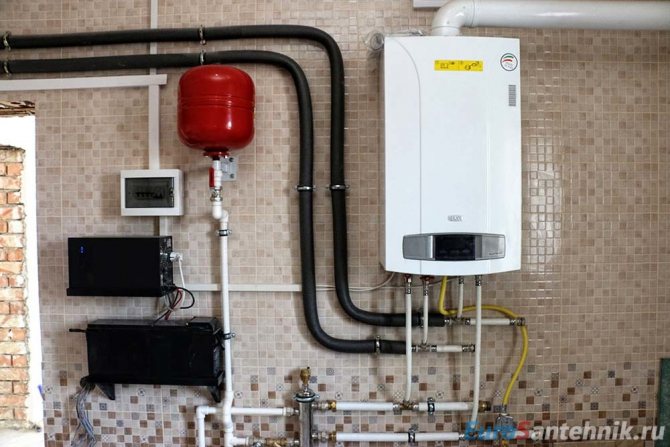

Gas heating is ideal for a country house. Round-the-clock warmth in the house at minimal cost - what else is needed. This type has a significant number of advantages:
- acceptable price;
- the ability to select the optimal boiler power depending on the heated area;
- the presence of a thermostat to control the level of heat;
- high equipment reliability;
- long service life of equipment;
- there is no need to regularly monitor the equipment and clean it.
There were also some drawbacks:
- permits are required due to the high risk;
- regular inspection of equipment by specialists is required;
- since carbon dioxide is emitted, ventilation is needed.
Of course, gas heating in a country house is possible if the main gas pipeline is connected. Unfortunately, the level of gasification in Russia is still at a negligible level. When it comes to the inexpediency of building a highway or remote areas, you can forget about gas.
There is an option of installing an autonomous gas tank, that is, a gas storage tank. In this case, all the advantages of gas heating are preserved, besides, complete independence of the owner of a country house is added.
But the gas tank requires increased accuracy and compliance with safety rules. For example, it is forbidden to fill a container with gas by more than 85%. To this you need to add regular inspections and considerable costs for installing and filling the cylinder.
What heating in a cottage is most profitable
If it is possible to connect to the gas main, this is ideal. Water heating in a cottage from a gas boiler was and remains the most profitable. It is best to use radiators as heating devices.


Warm floor in a cottage
An alternative to traditional batteries is a water-heated floor. However, in regions with harsh climates, floor heating alone will not be enough. You can choose a combined option: radiators and underfloor heating.
In the absence of gas, you have to choose which energy source is the cheapest. It can be electricity, solid or liquid fuels. When calculating, they are guided by the area, number of storeys of the cottage. The type of building materials, features of thermal insulation are also important.
For a comfortable stay, you need to take care of hot water supply. It often makes sense to connect a double-circuit boiler, which will simultaneously provide heating and the required amount of hot water.


Combined heating and hot water circuit
Economical alternative heating
Having analyzed the financial component of alternative types of heating, one can come to a disappointing conclusion - significant funds will be required at the initial stage. Now, after 3-7 years, depending on the chosen heating method, significant savings will become noticeable thanks to the non-volatile system.


It is profitable and convenient to use a combined source of alternative heating. To do this, you can choose the most optimal combination for your home.
It is possible to save on the use and installation of alternative installations for generating heat. Many home craftsmen are very enthusiastic about creating with their own hands analogs to factory devices for converting alternative energy. So, it is quite simple and inexpensive to assemble a solar plant from a hose, which will serve as an additional source of water heating.
Small windmills are successfully assembled at home from improvised means. Also, well-read farmers living in rural areas are constructing installations for converting biological waste of plant and animal origin into biogas.


Self-made wind generators are quite efficient. But to assemble them, you will need to make preliminary calculations, purchase consumables, spend your time
In the future, it is used for the needs of the farm. Depending on the size of the fermentation tank and the size of a private house, it is possible to fully supply the farm with biogas to meet all needs.
Comparison of costs of different heating systems
Often, the choice of a specific heating system is based on the starting cost of the equipment and its subsequent installation. Based on this indicator, we get the following data:
- Electricity. Initial investments up to 20,000 rubles.
- Solid fuel. The purchase of equipment will require from 15 to 25 thousand rubles.
- Oil fired boilers. Installation will cost 40-50 thousand.
- Gas heating with its own storage. The price is 100-120 thousand rubles.
- Centralized gas main. Due to the high cost of communication and connection, the cost exceeds 300,000 rubles.
Heating of a private house of the brine-water type by means of a heat pump
To implement such a project, a much deeper well will be required, its depth should be at least 200 meters. The pipes in the well should be U-shaped.
Remote control of heating of a country house
You can also equip such methods of heating a country house with a heat exchanger, which must be installed at a depth of at least 5 meters. Such a heat exchanger is needed in order to reduce the difference in heat received in different months.
One- and two-pipe heating systems
In a one-pipe water heating system of a cottage, the circulation of the coolant from the boiler and back is carried out along one line, which simultaneously plays the role of both supply and "return". As a result, the whole scheme is closed in one large ring encircling the building. And to this ring along the entire length of the pipe, the installation of heating radiators begins, with the help of which the coolant transfers energy to the living quarters.
The simplest diagram illustrating the principle of operation of a one-pipe distribution of a heating system
Like any other complex system, one-pipe heating distribution has its own advantages and disadvantages. What is a program for calculating the power of a heating boiler, you can read in our article.
Its advantages include the following.
- Saving on material - with a similar heating scheme for housing, one third less pipes are required. Consequently, the cost of arranging the heating system will be lower.
- Due to the line, which performs both the role of supply and the role of return, the costs of time and effort for the installation of the entire system as a whole are reduced.
- Compactness - with one-pipe wiring, the heating system communications take up less space. It is much easier to hide them in the wall or behind a decorative box.
- Simplicity - it is much easier to independently equip such a heating system for your cottage.


Single-pipe heating with bottom wiring
But for a low price and simplicity, one has to put up with one, but a very significant drawback of such a scheme - the impossibility of achieving an even distribution of heat over all radiators. At the beginning of the heating pipe, the batteries will be unnecessarily hot, and at the end, on the contrary, barely warm.
Advice! If for some reason you want to equip a one-pipe heating system, then you can solve the problem with uneven heat distribution as follows: from the boiler to the farthest point of the line, gradually increase the number of sections in the radiator. Due to this, the heat transfer of the system will be more uniform. The flip side of this approach is the increased costs of radiators, which call into question the main advantage of one-pipe wiring - cheapness.


Single-pipe vertical wiring is suitable for apartment buildings or with natural circulation of the coolant. For a cottage, it makes sense to give preference to the horizontal system. Often, at the same time, the main highway is "hidden" on the wall or under the floor surface.
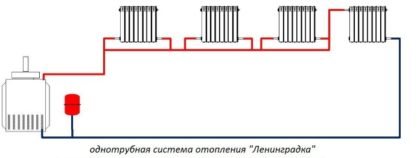

Leningradka is the most advanced one-pipe heating system. Each radiator is connected through tees and branches and is equipped with shut-off valves. With its help, the owner of a house with a one-pipe system can disconnect a separate battery from the mains without turning off the entire circuit as a whole.
A more modern and perfect scheme for arranging a heating system is a two-pipe wiring. Here, instead of one line, two are used - the first for supplying the coolant to the radiators, the second for draining it back to the boiler. These pipes are called respectively - "supply" and "return".
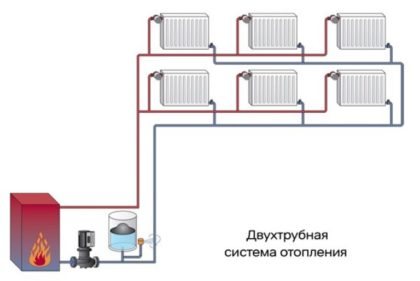

Picture illustrating the principle of operation of a two-pipe heating system
In many ways, the advantages and disadvantages of one- and two-pipe heating systems are mutually opposite. So, the pluses of the scheme with "feed" and "return" include the following.
- More even distribution of heat energy over the radiators. With a competent approach to regulation on the supply line, all radiators in the cottage will have approximately the same temperature. The situation when there is boiling water in the first radiator, and barely warm water in the second, does not happen here.
- Smaller pipe diameters required for laying such a heating system.
- The ability to regulate the temperature in each individual room using a thermostat and a tap on the supply line to the battery.
A two-pipe heating system has its drawbacks, there are two of them - increased material costs and the need to spend more time and effort on laying heating. Moreover, the first drawback is considered controversial by many owners of country houses - yes, more pipes are needed for heating with "supply" and "return", but at the same time their diameter is smaller. You will also need more compact (and therefore cheaper) fittings, connectors and valves.


An example of vertical and horizontal heating schemes


With the help of this diagram, you can easily understand the difference between one- and two-pipe distribution of water heating pipes.
Interesting! The best distribution of thermal energy between radiators can be achieved using radial distribution - when from the boiler to each individual radiator there are "supply" and "return" lines laid under the floor surface.Such a scheme requires a lot of time and money to install itself, but the result will be high heating efficiency.


An example of a radial two-pipe wiring of a heating system from a distribution manifold
Collector heat supply of the cottage
Collector heating of a cottage
How to properly make heating in a cottage if its area is equal to or exceeds 200 m². Even the installation of a two-pipe system in this case will be impractical. To resolve this issue, it is best to apply collector piping.
Currently, this is one of the most difficult ways to organize heating a cottage with your own hands. For uniform distribution of the coolant over a large area of the building, a multi-beam piping scheme is used. Immediately after the boiler, the main and return collectors are installed, to which several independent highways are connected. Unlike a two-pipe heating system of a cottage, a collector one provides for the possibility of regulating the operation of heat supply for each individual circuit. For this, control devices are installed - thermostats and flow meters.
The features of the self-made collector heating of a cottage include:
- Uniform distribution of heat along all circuits, regardless of their distance;
- Possibility of using pipes of small diameter - up to 20 mm. This is due to the small length of each node of the system;
- Increased pipe consumption. In order to correctly make collector heating in a cottage, it is necessary to draw up a diagram of the installation of pipelines in advance. They can be wall or floor mounted;
- Mandatory pump installation for each circuit. This is due to the high hydraulic resistance in the manifold. It can impede the circulation of the coolant.
When choosing a ready-made project for heating a cottage or when compiling it yourself, you need to take into account the heat losses of the building. The design capacity of the entire system will depend on them.
For two and three-storey cottages with a large area, a heat supply system diagram with several distribution manifolds is best suited.
Biogas plants
In order for gas generating plants for biogas production to work most efficiently, the substrate that is loaded into the reactor must be crushed. When processing plant waste (branches, leaves, weeds), garden garbage shredders are used. Among them there are quite powerful units that can turn branches up to 20-25 cm in diameter into small chips.
Food waste disposers are used to grind food waste that ends up in the sewer system. Such a device is connected to the kitchen sink and connected to the sewage system. The crushed waste is loaded into a container for biogas production - a gas generator. The substrate is mixed with a certain amount of water and substances are added to it that will accelerate the biodegradation of the waste. The biogenerator constantly maintains a temperature of about + 25 ... + 30 degrees. The contents of the tank are automatically mixed several times a day.
After about a week, an active fermentation process begins in the bioreactor, accompanied by the release of biogas. Further, biogas enters a wet gasholder, which is a container filled with water. A cap is placed in the water, to which pipes from gas-generating systems are connected. When the hood is filled with gas, it floats to the surface, turning on the compressor, which pumps the produced gas into the gas storage.
The main elements of a water heating system
The main elements of a hot water heating system include:
- boiler;
- a device that supplies air to the combustion chamber;
- equipment responsible for the removal of combustion products;
- pumping units that circulate the coolant along the heating circuit;
- pipelines and fittings (fittings, shut-off valves, etc.);
- radiators (cast iron, steel, aluminum, etc.).
Boiler selection by the number of circuits
For heating the cottage, you can choose a single-circuit or double-circuit boiler. What is the difference between these models of boiler equipment? A single-circuit boiler is designed only for heating the coolant intended for circulation through the heating system. Indirect heating boilers are connected to single-circuit models, which supply the facility with hot water for technical purposes. In double-circuit models, the operation of the unit is provided in two directions, which do not intersect with each other. One circuit is responsible only for heating, the other for hot water supply.
Boiler selection by fuel type
The most economical and convenient type of fuel for modern boilers at all times has been and remains the main gas. The efficiency of gas boilers is not in dispute, since their efficiency is 95%, and in some models this indicator goes off scale for 100%. We are talking about condensation units capable of "pulling" heat from combustion products that fly away in other models simply "into the chimney".


Heating a country cottage with a wall gas boiler is one of the most popular ways to heat living space in gasified regions.
However, not all territories are gasified, therefore boiler equipment operating on solid and liquid fuels, as well as on electricity, is very popular. It is even more convenient and safer to use electric boilers for heating a cottage than gas, provided that the region has a stable operation of power grids. Many owners are stopped by the cost of electricity, as well as the limitation of the rate of its supply for one object. The requirement to connect the electric boiler to a three-phase network with a voltage of 380 V is also not to everyone's liking and affordable. It is possible to make electric heating of cottages more economical by using alternative sources of electricity (wind turbines, solar panels, etc.).
Liquid fuel boilers are installed in cottages built in remote regions, cut off from gas and electric mains. Diesel fuel (diesel fuel) or waste oil, if there is a source of its constant replenishment, is used as fuel in these units. Solid fuel units operating on coal, wood, peat briquettes, pellets, etc. are very common.


Heating a country cottage with a solid fuel boiler operating on pellets - granular wood pellets that have a cylindrical shape and a certain size
Boiler selection by power
Having decided on the type of boiler equipment according to the fuel criterion, they begin to select a boiler of the required power. The higher this indicator, the more expensive the model, therefore, one must not miscalculate when determining the power of the unit purchased for a particular cottage. You can't follow the path: the less the better. Since in this case the equipment cannot fully cope with the task of heating the entire area of a country house to a comfortable temperature.
The unit will be especially weak on cold days, when the thermometer will show abnormally low temperatures outside the window. Therefore, it is recommended to purchase boilers with a slightly higher power than the calculations show, but not much higher. Why overpay money, and then force the equipment to work "idle"?
Geothermal systems
New heating systems for private houses make it possible to obtain energy that can be used not only for heating, but also for other purposes.The most popular way of generating energy is considered to be the use of geothermal installations. Such installations work on the same principle as a heat pump. Heat intake is provided from the ground, which is located in the immediate vicinity of the house.


Geothermal heating system
A geothermal installation, as an innovation in home heating, has the following design: a heat pump is installed in the house, which will be fully responsible for pumping the coolant. It is necessary to lower the heat exchanger into the shaft located near the house. This heat exchanger will transfer groundwater to the heat pump. Passing through the pump, they will lose some of their heat. This is because the pump will take heat and use it to heat the house.
If you need geothermal innovative heating of a country house, then the coolant should not be groundwater, but antifreeze. To do this, you will need to equip a tank designed for this type of coolant.
Which heating radiators to choose
Despite the varieties of the heating system, in any case, special equipment is required with the help of which heat enters the cottage: heating radiators, batteries. All heating equipment can be divided into 4 types:
1) Cast iron radiators are an excellent heat carrier. But they are not without the risk of water hammer, which can damage them during the heating season. Since the inner surface of the radiator is rough, it is capable of accumulating limescale, which blocks the flow of heat into the room. When choosing a cast-iron radiator for a cottage, it should be taken into account that a local heating system is installed.
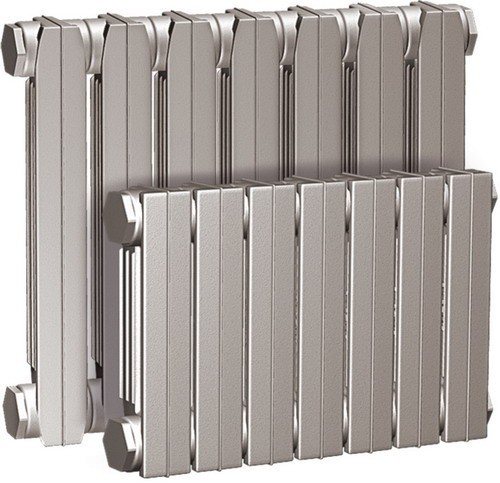

2) Steel radiators more resistant to water hammer and do not have the disadvantages of cast iron batteries, they transfer heat better. But they are not resistant to corrosion, rust can form on the inner wall, which requires careful maintenance of the batteries, or too frequent replacement is required.


3) Aluminum radiators lightweight construction, excellent heat conduction, corrosion resistant, but not able to withstand water hammer. If the cottage uses a local heating system, then such a radiator can be an excellent solution.
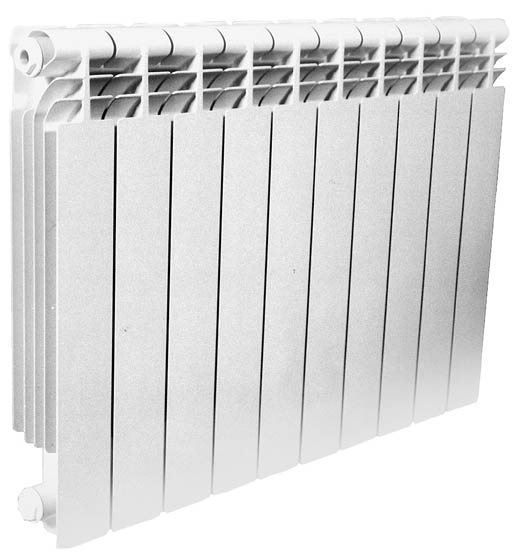

4) Bimetallic radiators most effective. They are resistant to corrosion, water hammer, do not form scale on the inner surface, and give off more heat. Among the shortcomings, only the high price was revealed.


The number of radiator sections: how to correctly calculate


Number of battery sections: correct selection
The calculation of the heating system is carried out with the obligatory selection of the number of radiator sections. A rather simple formula can also be used here - the area of the room, which is supposed to be heated, must be multiplied by 100 and divided by the capacity of the battery section.
- Room area. As a rule, all radiators are designed to heat only one room, and therefore the total area of the house is not needed. The only exception is if there is a room that is not equipped with a heating system next to the room that is being heated;
- The figure 100, which appears in the formula for calculating the number of radiator sections for a heating system, is not taken from the ceiling. According to the requirements of SNiP, about 100 W of power is used per square meter of living space. This is enough to maintain a comfortable temperature;
- As for the power of the heating radiator section, it is individual and depends, first of all, on the material of the batteries. If it is impossible to accurately determine the parameter, then 180-200 W can be taken for calculations - this corresponds to the average power of the section of modern radiators.
Having received all the data, you can start calculating the heating batteries. If we take as a basis the size of the room is 20 m2, and the power of the sections is 180 W, then the number of elements of heating radiators can be calculated as follows:
n = 20 * 100 | 180 = 11
Advice. As in the case of the boiler power, the number of battery sections must be taken "with a margin", this will allow you not to worry about severe frosts.
It should be noted that for rooms located at the end or at the corner of a building, the result obtained must be multiplied by 1.2. Thus, it will be possible to achieve the most optimal values, to determine a sufficient number of radiator sections for heating a country cottage.
Electric heating
Some people think that heating a house with electric fireplaces is somewhat unjustified due to high energy tariffs. But there are pluses here: ease of installation and low prices for the equipment itself. In addition, electric heating does not require the construction of a chimney, since it simply does not emit harmful combustion products during use.
An electric boiler has a lot of all kinds of advantages from its use, which are not found in other systems. That is why, if you do not have the funds to build a fireplace or stove, and you cannot get permission to install gas equipment, use the electric option of heating a suburban home.
The following are currently in use types of electrical systems
:
- Electric boilers;
- Tubular electric heaters;
- Warm floor;
- Electric convectors;
- Infrared heaters;
- Thermal air systems.
More details. So, the best option for electric heating is a boiler. The principle of its operation is similar to the gas installations described above. Also, heat energy is transferred to the coolant, and heated antifreeze or water is distributed throughout the house using pumps. Electrode boilers are convenient, they conduct electricity through the non-freezing liquid, thereby heating it to increase the temperature.
Alternatively, tube-shaped electric heaters. In operation, they are similar to a boiler, but difficult to install.
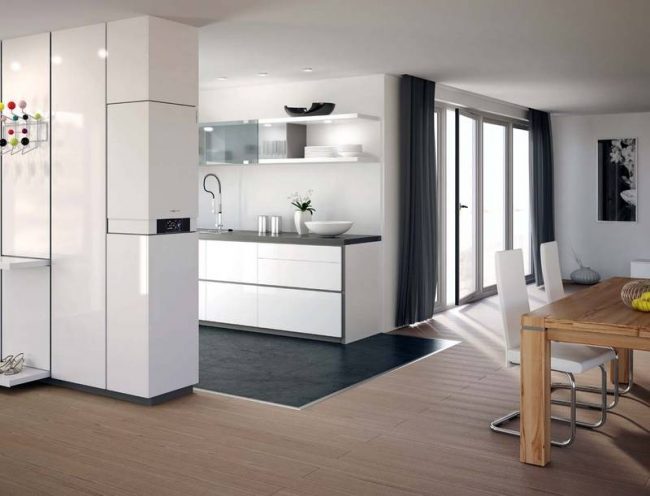

Underfloor heating is a system of wires that are embedded in the base floor. The structure is connected to the network, the heat begins to heat the floor, and from there it rises upward and evenly spreads throughout the room.
Convectors are similar in appearance to batteries, especially since they are connected to the wall. The convectors are connected to the network, they heat up and only after that the air begins to rise.
Infrared heaters are lamps that transform electricity into a stream of heat rays. Since the lamps are quartz, they heat not only the air, but also all objects that are in the path of the air stream. The devices are either wall-mounted or fixed to the ceiling of the room.


Interestingly, infrared heaters, being considered the most productive, are used even on verandas and terraces.
And, finally, there is one more option for heating the dwelling at the expense of the network - the last one is fan heaters. Systems of this type are compact, therefore they are excellently used as an additional heating means. There is one drawback of a fan heater - they dry the air in the home too much.
Cottage heating system installation
After equipping the boiler room, according to the cottage heating scheme, radiators are mounted. The main parameters by which consumers choose radiators: dimensions, power and material from which they are made.
Internal wiring
When installing a cottage heating system, special attention should be paid to the pipe material. Today there are several types of pipes that are traditionally used in heating systems. Let's take a closer look at these types.
- Steel pipes. Robust, resistant to pressure drops, but difficult to install and corrosive. Over the years, a layer of rust accumulates on the inner walls, which can impede the flow of water.
- Reinforced-plastic pipes. Durable, flexible and easy to install. It is convenient to use with complex geometry of the heating system. But they also have a number of weak points: they are destroyed by mechanical stress and ultraviolet radiation, as well as combustible.
- Propylene pipes. The most popular material, which is undoubtedly related to the price of such pipes. They are the most economical compared to their other pipe materials. They have only one drawback - good flammability. Otherwise, it is an ideal material for heating pipes. They do not rust, do not crack, are easily welded using special "irons", and are durable in use.
- Stainless steel pipes. They are usually used in non-residential premises: basements, laundries, billiard rooms. They have good heat dissipation, and so high that they can heat the room without installing radiators. Variety - corrugated stainless steel pipes. In addition to the above, they have one more advantage: they easily "bypass" corners and turns without additional joints.
Crimping
Before starting the heating system, it is necessary to check all nodes and connections. For this, the system is pressurized. That is, air or water is injected under a pressure 2-2.5 times higher than the working pressure and left for a day. During this time, leaks are detected and eliminated at the joints of the system parts. It is recommended to heat the boiler for the first time by no more than 40 C. After filling the entire system with water, each radiator is checked for warming up and the entire heating system as a whole. After checking, the heating power of the boiler can be increased.
Country house: heating by the sun
Solar energy, emitted by the luminary all year round, is capable of becoming an alternative form for heating a suburban home even in severe frosts. It is important to learn how to properly assemble and use it in the heating system.
To collect and convert the energy of the sun, solar panels are used on photovoltaic converters and collectors, which are a system of tubes filled with a coolant.
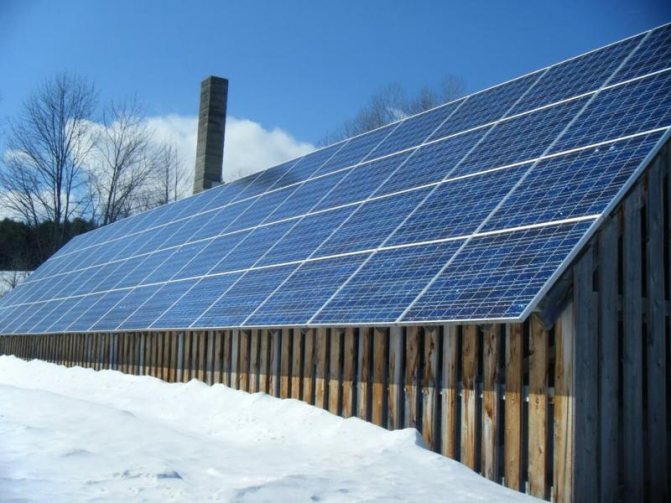

Solar installations have a high efficiency. Many zealous owners independently equip their homes with such systems.
The fundamental difference between these converters is that the batteries generate a current that can be used for electric heating of a country house. Collectors are used in water and air heating systems. The most effective option is to install underfloor heating systems in the premises.
The opinion that the sun is not able to cope with the heating of the house is true only in the case of incorrect installation and erroneous calculations of the amount of required energy and heat. An optimally selected solar plant is quite capable of providing autonomous heating. Another question is that this will require investing money in the purchase of equipment, its installation and integration into the existing heating system.
How the solar system works and works
A solar system based on photovoltaic converters absorbs solar energy, and silicon solar cells immediately convert it into direct electric current. 1 m2 of the installation is capable of generating 120 watts. In addition to panels that capture solar radiation and convert it, a charge controller, a DC-to-AC converter will have to be installed for the solar heating system, and safety concerns - fuses will be installed.
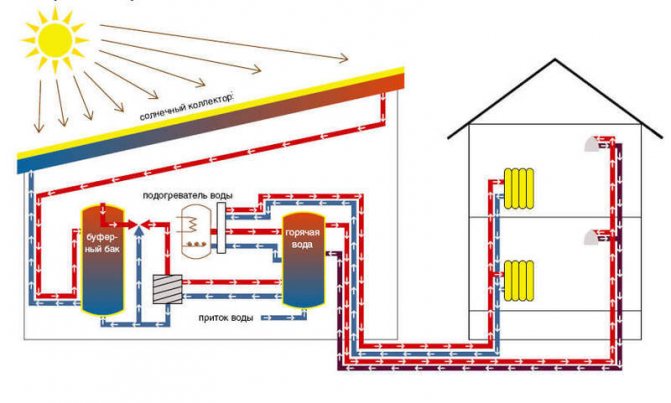

Before deciding on the installation of solar installations, you need to understand their structure and principle of operation.
The advantage of the panels is the ability to connect rechargeable batteries that accumulate excess energy, which can be used at night. A significant drawback when using solar batteries is their greatest efficiency in the southern regions. In harsh climates, it is economically impractical to install them for use as the main type of heating.
Solar installations equipped with a tube system are more suitable for regions with cold winters and freezing temperatures. Depending on the structure of the panel and materials, a distinction is made between vacuum collectors, flat collectors and concentrators. The most expensive ones are with vacuum tubes. But they are the most effective at any time of the year and in any weather, because they can absorb a wide range of solar radiation. Another advantage of them is that vacuum panels operate successfully at temperatures as low as -35 ° C.
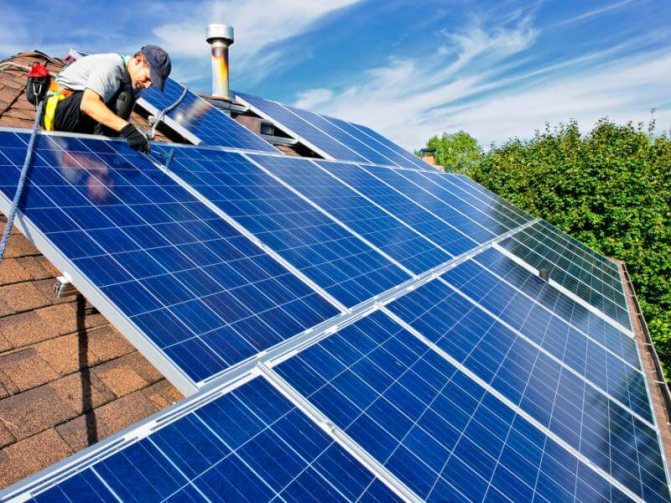

You can install solar collectors with your own hands, without using the services of organizations specializing in this. Such work will require an assistant, but will save the family budget.
The principle of the collector is that it captures solar radiation, which is converted into heat in vacuum tubes. Then it is transferred to the coolant, which delivers it to the heat exchange tank. Then the coolant enters the heating system.













